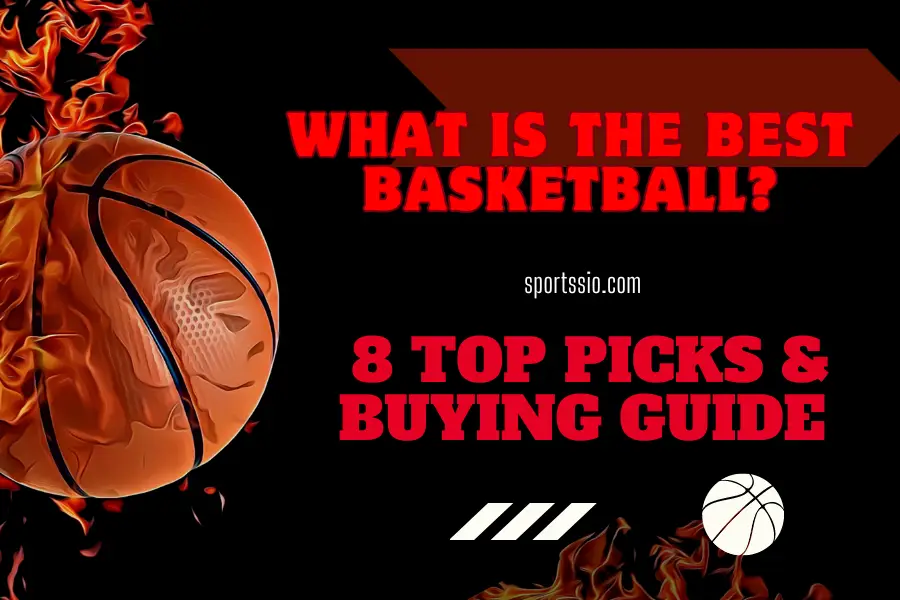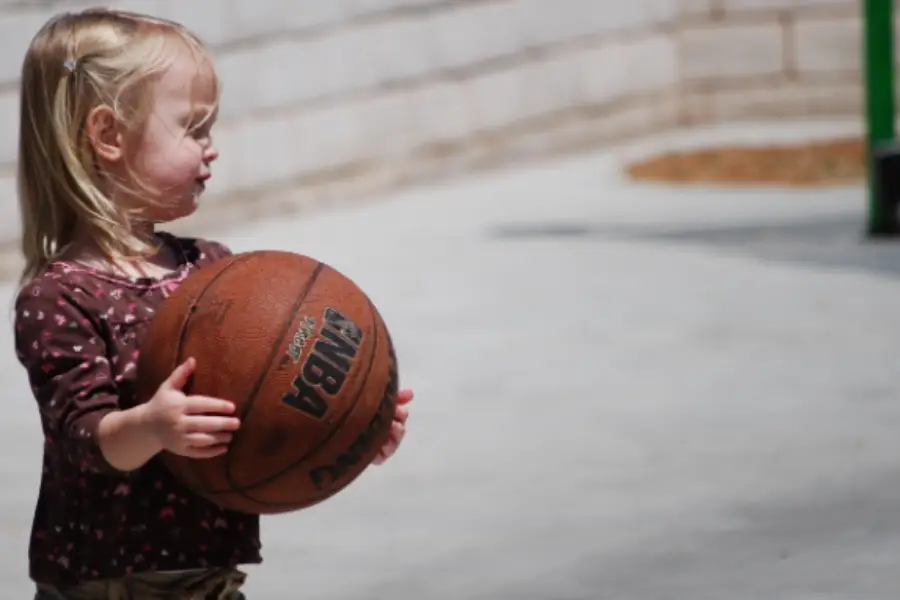
What is the best basketball? I’ve been around the block and sunk more hours into this question than I can count. Why? Because the quality of the rock you’re gripping plays a massive role in your game, whether you’re a wide-eyed rookie or a seasoned vet.
Every little detail matters in how the ball performs, from grip to bounce to durability. Keep reading, and I’ll break down the need-to-know factors and top picks to help you find your perfect court companion.
Our Top Picks

Champion Sports Pro-Style

ANDI Chaos
What is The Best Basketball?
Wilson NCAA Final Four – Best All-Surface
Pros
- Exceptional grip for indoor and outdoor
- Durable construction for extended use
- Consistent, predictable bounce on any surface
- Accurate passing capabilities
- Two size options are available
Cons
- May require frequent re-inflation
- Bounce may not suit everyone
If you need a ball that can go anywhere and handle whatever you throw at it, the Wilson NCAA Final Four is hard to beat. For that all-surface versatility, it’s tough to top this one.
A few things stood out when I first got my hands on this ball. The classic brown color gives it that traditional basketball look that never goes out of style. The surface has this high-definition pebble design that promises an improved grip. And the premium carcass construction makes you think this ball is built to last and provide a nice rebound.
Indoors, on the wooden surface, the pebbled cover delivered exceptional grip even during intense play. Dribbling and ball handling felt super natural and controlled for me. Thanks to that premium construction, my shots had this consistent, predictable bounce.
Then I took it outside to the concrete court, and I was impressed by how well the grip held up on the rougher surface. The pebbles prevented any slippage during dribbles and shots. Passing accuracy was on point, too, whether I was making quick dishes or firing long outlet passes.
Now, it’s not all perfect. Some users have reported issues with air retention, too. This means you might need to re-inflate it more often than you’d like. The bounce also seems to be a bit polarizing—some find it too bouncy, others not bouncy enough.
Wilson Evolution – Best Indoor
Pros
- Durable build that retains shape well
- Great grip and control
- Super consistent, responsive bounce on indoor courts
- Soft, cushioned feel
- Available in multiple sizes
Cons
- Quite expensive
- Some rare quality control issues
When your game never leaves the smooth embrace of the hardwood floor, the Wilson Evolution might be your perfect match.
This one has a soft, cushioned composite leather cover that feels amazing in your hands. The deep grooved channels give you good grip and control—way better channeling than some cheap indoor balls with thin, shallow grooves.
Where this ball really shines is on indoor hardwood courts. The soft composite cover provides an insane grip. When I’m dribbling or making passes, it feels like the ball sticks to my hands almost too well.
The Evo Microfiber fabric does the job there. And you get great spin and control on shots with that textured surface. Even when my hands get sweaty, the moisture-wicking fabric keeps things from slipping.
Those deep channels also deserve another mention for dribbling. With all the grip and control you get, you can work some magic. Bouncing the ball feels natural and responsive; there are no weird inconsistencies to throw you off your rhythm.
There are a couple of things to keep in mind. This popular indoor specialist is a bit pricey. And you definitely shouldn’t take it outside—it’s an indoor-only deal. There have been some rare cases of defective balls that don’t hold air for long, but that’s not super common, and most places will happily replace a faulty ball.
Spalding Rookie Gear – Best for Teens
Pros
- Works on multiple surfaces
- Ideal size and weight for youth
- Durable composite cover
- Bright color options
- Helps develop skills
- Good value
Cons
- May lose air quicker than expected
- Bounce could be better
The Spalding Rookie Gear is something you should check out when you’ve got a young baller in the house. This ball is practically built for teens looking to up their game without breaking the bank.
First things first, this ball doesn’t shy away from color. I’m talking orange, lime green – stuff that practically pops off everywhere. It also has a composite cover that feels grippy, not super fancy leather, but not slippery. And here’s the cool part: this ball is surprisingly light. Spalding says it’s 15% lighter than a standard basketball, which may be a big difference for a teenager.
I tested this one out with my 13-year-old son; the lighter weight was a game-changer. He could handle the ball way easier, dribbling and passing with more confidence.
We took it to both the indoor and outdoor courts in the neighborhood, and it performed well on both surfaces. The grip wasn’t top-notch, but it was decent enough for him to control the ball without any problems. Even though it’s light, the bounce was surprisingly good. Shooting felt natural, and he was even draining a few threes (I’m not sure where he learned that!).
Some folks mentioned it might not hold air, as well as some other options. Also, a couple of reviews mentioned the bounce being a bit inconsistent. I didn’t experience this myself, but it’s worth keeping in mind.
Wilson DRV Pro – Best for Beginners
Pros
- Excellent grip for beginners
- Good air retention
- Durable for outdoor play
- Responsive bounce
- Textured surface with more control
Cons
- Not for indoor
- Basic packaging
If you’re just starting with basketball, the Wilson DRV Pro needs to be on your radar. This ball is tailor-made for hoopers who are still getting a feel for the game.
Right off the bat, you can tell Wilson went the extra mile on the design and materials here. The cushiony Tackskin cover provides grip for days right out of the box. No break-in is required. And with color options like the classic brown, red, or gray, it just looks super sleek and premium.
But the real star is how that tacky surface translates to performance, especially for new ballers. As a beginner, having a ball that sticks to your hands is crucial for developing skills like dribbling.
The DRV Pro’s grip allowed me to work on my handles more confidently. In fact, I could easily palm the ball at any angle without it budging. This confidence is a huge help when you’re just starting out.
The bounce is also nice and responsive, which is great for developing proper shooting form. The channels and textured surface also provide excellent feel and control when passing the ball to teammates.
The only real knock is that it’s not really an indoor ball. Oh, and some users reported packaging issues where the ball looked kind of used out of the box. It’s not ideal if you’re giving it to someone.
Mikasa BX1000 – Best for Small Kids
Pros
- Ideal size for kids 4-6 years old
- Soft rubber construction for safety
- Maintains air pressure well
- Affordable price point
- Smooth surface for better control
Cons
- Limited to flat outdoor surfaces
- No pump included
After testing out a bunch of balls for little ones, this one’s a slam dunk for parents with kiddos in the 4-6 year old zone.
The size 4 circumference is perfect for those tiny hands. My 5-year-old nephew could easily palm and control the ball without any issues. A full-size ball would just be too much for him at this stage.
I love the soft, kid-friendly construction. The rubber material has just the right amount of give. When my nephew missed a rebound off the mini hoop, and it nailed him in the face, he barely flinched. There was no stinging, no tears—he just shook it off and kept balling.
The molded seams create a nice, smooth surface that little ones can control. My nephew could do basic dribbling and passing without the ball unexpectedly ricocheting off his hands. And while it’s not the bounciest ball ever, it still had enough life coming off the concrete to make shooting fun and rewarding.
After an hour of pretty intense park action, the BX1000 still maintained its shape and air pressure. The only real downside is that there’s no pump included, so factor that into the cost. And it’s meant for flat, outdoor surfaces rather than an indoor wood court.
Spalding Street Phantom – Best Outdoor
Pros
- Shipped inflated and ready to use
- Exceptional grip for outdoor courts
- Solid weight and feel
- Durable sponge rubber construction
- Maintains performance when wet
- Handles court imperfections well
Cons
- Limited size choices
- Rubber cover may wear faster than some indoor balls
- Not go well with water and dirt
This is your best bet when you want something built tough to dominate the blacktop.
The Spalding Street Phantom captured my attention the moment I opened the box. My order’s color scheme is a slick black and neon blue vibe. It’s not your traditional basketball look, but I’m digging it. No pumping is required; everything is ready to rock.
The Street Phantom shines in outdoor use because of its sponge rubber construction reinforced with Soft Grip Tech. That texturing gives you an insane grip, even on the roughest blacktop surfaces. There are no slick spots to worry about here. The weight distribution feels just right when you’re palming the ball, so those with bigger hands can really get a grip on it.
Now, this ball takes a little break-in at first. It can feel super bouncy and lively until it gets worked in. But after a couple runs, the Street Phantom settles into its groove.
Never once did I feel like I was losing control, even when things got sweaty. The grip held up incredibly well from start to finish. Dribbling and shooting felt super responsive, too.
This ball can seriously take a beating, too. We’re talking cracks, debris, you name it. Nothing seemed to faze the Street Phantom. And after hours of play, that sponge rubber cover showed no wear and tear.
The only real downside is that the cover isn’t meant for indoors. The soft rubber might not fare so well against the smooth wood of an indoor court. Rain and dirt are also its kryptonite – a wet and muddy Street Phantom is a recipe for a bricked shot and a ruined ball.
Champion Sports Pro-Style– Budget Choice
Pros
- Cheap price
- Good rubber construction for the price
- Nice bounce and grip for casual players
- Versatile for indoor/outdoor play
- Bright color options appealing to kids
Cons
- Doesn’t hold air for extended periods
- Less bouncy and grippy compared to premium balls
Balling doesn’t have to break the bank, and that’s where the Champion Sports Pro-Style comes in. This isn’t your fancy, top-of-the-line number. But for casual players or youngsters just getting started, it’s a solid pick.
Here’s the deal: the Pro-Style ball is all about fun and affordability. It comes in a bunch of cool colors, like a bright blue that practically pops off the shelf. Perfect for grabbing a kid’s attention and getting them excited to shoot some hoops. Speaking of kids, this one comes in the junior size 5, ideal for young ballers up to 11 years old.
Despite being an affordable ball, the rubber composite cover doesn’t feel too bad. It’s obviously not premium leather, but it has a nice texture and sleek design that almost looks pro-level at a glance.
Once you get it pumped up, though, the Pro-Style delivers a pretty decent performance for casual play. The bounce and responsiveness were definitely enough to have fun dribbling and shooting around in the driveway. The rubber cover provided a decent grip, too. It’s obviously not mind-blowing, but enough for most players to feel in control.
Another cool thing? This ball can handle both indoor and outdoor courts. I took it out to my concrete driveway. It held up great, even with the usual suspects like leaves, twigs, and the occasional rogue pebble.
Now, don’t expect this to be a pro-grade ball. It won’t hold air for weeks on end, and the bounce isn’t going to be top-notch. But for casual play or getting your little ones hooked on hoops, this is a winner.
AND1 Chaos – Best Value
Pros
- Good value for the price
- Stylish design
- Playable on both indoor and outdoor surfaces
- Pump and needles included
- Good grip
- Responsive bounce
- Decent durability
Cons
- Loses air a bit faster
- The grip is not as good as premium balls
When shopping for basketballs without a big budget, expectations can’t be too high. But the AND1 Chaos seriously over-delivers for its modest price tag.
This ball has a fresh, eye-catching look with bright colors and flashy graphics. If you’re into that style, the Chaos will definitely appeal. It is not everybody’s vibe, but as a streetball-inspired brand, AND1 nails that urban aesthetic.
The rubber material gives it a solid weight in your hands, not too light or heavy. Remember that it only comes in size 7, so it’s not ideal for younger kids. A pump and needles are included. Just a heads-up: some folks online mentioned the needles bend easily, so be careful when you pump it.
The real kicker is the performance, which is pretty good for the price. Once you’re all set up, the deep channels provide excellent grip, even when your palms get a little sweaty during an intense game.
The rubber also gives it a responsive bounce for shooting. I didn’t notice any dead spots, and everything felt super natural and smooth. I even tested it out on the concrete court, and it held up well with no weird slicks or slides.
Now, there are a few inevitable downsides at this price point. You may notice the gradual air loss over time. Also, the grip, while decent, isn’t the super tacky feel you get with some premium balls. Some folks might prefer a bit more bite.
Things to Consider When Buying a Basketball
Size
Don’t just default to a standard size 7 ball without considering who will use it.
Size 7 (29.5″ circumference) is the official size used for men’s high school, college, and pro games. Its larger dimensions provide maximum control for players with larger hands, especially adult male recreational players.
Meanwhile, size-6 balls (28.5″) are perfect for younger players and women with smaller hands. Many high school and college women’s teams use this size. It’s also a good choice for teen boys growing into their frames.
In youth sports, size 5s are the way to go for kids under 12 or so. The smaller grip allows them to palm and control the ball easily as they learn fundamentals like dribbling and shooting form. It also prevents overtaxing their smaller hand and wrist muscles.
Smaller sizes like 4 and even 3 are available as well. They’re a great choice as starter balls for little kids just being introduced to the game. These are lightweight and have a circumference that fits perfectly in those tiny hands.

Material
Leather
Leather was the standard for game balls, and you still see it with the official NBA rock. The leather covers deliver excellent grip and touch and, once broken in, solid indoor durability. But genuine leather has mostly fallen out of favor for recreational ballers due to its premium pricing.
Composite and Synthetics
These days, composite materials are the best choice for high-performance non-leather covers. However, composite materials are a nebulous term, and there is no strict definition separating them from synthetics.
Manufacturers typically use “composite” labeling for their higher-tier balls aimed at serious players. The covers typically consist of polyurethane bonded to non-woven fabric for maximum grip and feel. Most composite balls are indoor/outdoor rated, though some have indoor limitations.
For a straight-up synthetic option, you usually look at PVC or polyurethane/PVC covers bonded to woven or non-woven fabric backings. They are not quite as elite as composite in touch and control, but they are great all-around performers.
Rubber
Then you’ve got rubber balls made for pure outdoor recreation. Rather than a cover material, the pebbles or grooved texture is molded directly into the rubber surface.
Rubber provides an awesome bite and grip when dry but can become super slippery if wet. The upside is excellent abrasion resistance against concrete courts and rougher surfaces. Some even have an outer layer of foamed rubber to boost grip and soften the feel.
Play Location
Indoor balls are designed for wood court surfaces. They have a higher grip and softer cover that provides better control. Outdoor balls have a more durable rubber cover to withstand concrete and asphalt. The trade-off is they don’t grip as well indoors.
If you split your time between both, look for an all-surface ball. It won’t excel in either setting, but it gets the job done.
Durability
Remember, cheaper rubber or composite covers won’t last as long before the grip wears down.
Genuine leather is the premium option – it’s soft yet durable. Expect to pay more, but a good leather ball can keep its grip for years with proper care. Look for a thicker rubber cover for outdoor play that can handle much court time.
What Are the Best Basketball Brands?
Spalding
You can’t talk hoops without mentioning Spalding. This iconic brand had an over 30-year run as the official ball provider for the NBA up until 2021. Their showpiece is those butter-soft premium leather game balls with unbeatable grip and an insanely satisfying bounce and feel.
Wilson
Wilson took over as the NBA’s official game ball starting in the 2021-2022 season, but they were already a major player with their Evolution series. As I’ve mentioned above, this lineup is famous for its soft composite covers and all-around durability on the hardwood. Many pros and amateur ballers have fallen in love with that distinct Wilson touch.
Nike
While they don’t have an exclusive partnership, you’ll find Nike balls used everywhere from Euroleague play to youth tournaments across the globe. Their designs consistently push boundaries with things like grip-enhancing channeling and cushioned cores.
Molten
This is the official game ball provider for FIBA (International Basketball Federation). Molten rocks get prime time at the Olympics and other elite FIBA events. They’re best known for that distinctive 12-panel design that offers superior fingertip control and visibility compared to traditional 8-panel construction.
Conclusion
What is the best basketball? At the end of the day, it all comes down to finding the right match for your skillset, playing environment, and overall needs.
More than anything, I want you to spend more time on the court working on your game rather than endlessly researching balls online. So trust your instincts, maybe try before you buy, and most importantly, have fun once you’ve found your new pick.










